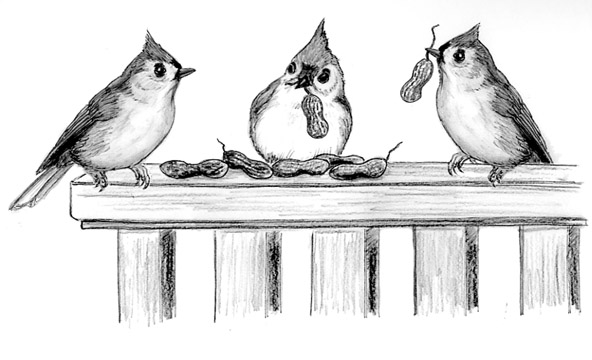
Dear Bird Folks,
I have several Tufted Titmice coming to my yard nearly everyday. I give them whole peanuts that are still in the shell. The birds take the whole peanuts and fly away with them. After they fly away I can’t see where they go or what they do with the nuts. My question is: Do they eat the peanuts or do they hide them someplace for later? I’m wondering because they sure take a lot of peanuts for such small birds.
– Peg, Brewster, MA
You have lucky birds, Peg,
They are lucky because they get peanuts. The birds in my yard get nothing but the same monotonous sunflower seeds day in and day out. In this economy that’s all I can afford and sometimes they don’t even get that. Occasionally I have to leave an IOU in my feeder. The birds aren’t happy but they understand. They know things are tough right now. There once was a time when I could afford to put out peanuts, too. It was back in the roaring nineties and Bernie hadn’t stolen everybody’s money yet. I filled my feeder with peanuts and the birds loved them. Everything was going swell until the neighborhood elephants caught wind of the peanuts and that’s when things turned ugly. I couldn’t keep the darn things away. I tried banging on the window and clapping my hands; I even greased the feeder pole, but still the elephants got into my feeders. Wait, I might be confusing elephants with squirrels. Which one has the fluffy tail? Let me get back to you on this.
I’m glad you are asking about titmice. They are totally underrated birds. While cardinals, hummingbirds and bluebirds grab all the headlines, the lowly titmouse regularly comes and brightens up our yards with little fanfare. It’s probably their generic gray plumage and quiet personalities that cause us to take them for granted. The only thing the makes these birds stand out is their whacky name. Titmouse? Whose idea was that? But underneath all their plainness Tufted Titmice are tough and interesting birds.
Let’s begin by talking about their toughness. Titmice are nonmigratory. That means the birds you see at your feeder in July are most likely the same birds you’ll see clinging to your feeder during a February Nor’easter. Right now you may be wondering: “What’s so special about that? Chickadees are smaller than titmice and they are out in the same nasty weather.” That is true, but chickadees have been around here for centuries and have had time to evolve ways of dealing with our nasty weather. Titmice are basically southern birds and are fairly new to this area. The first titmice didn’t breed in Massachusetts until 1958, when a pair nested in someplace called “Waban.” Waban? I don’t know how the titmice ever found Waban because I’ve lived in Massachusetts all my life and I’ve never heard of it. Waban? Who named that town, Elmer Fudd?
In order to survive New England’s and Waban’s frigid winters, titmice gather food in the fall and stash it away for the winter, and that’s exactly what they were doing with your pricey peanuts. Each nut is removed from its shell and then carefully hidden in a crevice or under a piece of tree bark. With any luck the food that the birds have worked so hard to store this fall will be waiting for them when winter’s snow and ice covers their natural food supply.
Tufted Titmice may be unafraid to face winter head-on, but there is one thing that they are totally afraid of and it’s kind of surprising. According to local super birder Vern Laux, titmice hate water, or at least they hate to fly over it. Even a body of water as narrow as the Cape Cod Canal is too scary for titmice to cross. So how did these birds ever colonize the Cape without flying over the canal? They got here the same way we do; they used the bridges. Back in the 70s, when the titmice on the mainland had a population explosion, witnesses claimed to have seen dozens and dozens of titmice moving across the bridges. The birds flew from one girder to the next, slowly working their way across the bridges until they reached the other side (the good side).
Once on the Cape the birds settled in and their population grew rapidly. However, the nearby island of Nantucket still has no Tufted Titmice; these hydrophobic birds won’t fly across Nantucket Sound. Tiny hummingbirds annually make the 500-mile trip across the Gulf of Mexico, while the much larger titmice refuse to make the short flight to Nantucket. If Nantuckians want titmice they are going to have to build them a bridge or buy them a ticket on the high-speed ferry.
I’m glad you are enjoying the titmice, Peg. It’s nice to know that someone appreciates them. I just hope the neighborhood elephants don’t discover the peanuts in your feeder. Which reminds me. I have a question for you. What is gray and has a trunk? Give up? It’s a titmouse going on a trip. Get it? The titmouse is gray and it needs a steamer trunk to carry all its peanuts in. I don’t know where it is going, but it probably won’t be Nantucket.